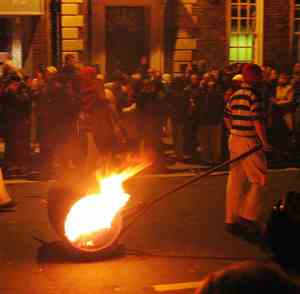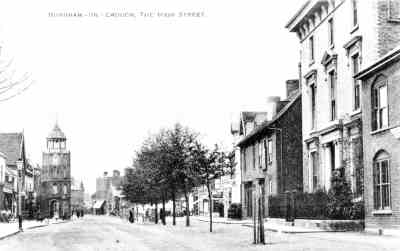The origins of Burnham Carnival
One of the regular festivities in Burnham on Crouch over several hundred years was to hold a bonfire in the High Street with young men holding races through the town while pushing burning tar barrels. This practice seems to have gained a good volume of support although it was not popular with all residents of the town.
Although activities on 5th November in Burnham are first recorded in 1856 they probably date to the Gunpowder plot in 1606 when the grateful King declared the day a public holiday which was celebrated with fireworks and bonfires where an effigy was burned. This effigy initially was either the Pope or Guy Fawkes but with the passing years became mainly that of Guy Fawkes. This tradition was maintained through the years and is still celebrated to this day.
The Book of Days published in 1888 provides details of the activities - The universal mode of observance throughout England is the dressing up of a scarecrow figure, parading it through the streets and at nightfall burning it on a bonfire with great solemnity.
In Burnham the tradition seems to have continued with often a male and female effigy being burned and races through the streets with burning tar barrels that were steered with sticks rather like children's hoops rather than carried which was the common practice elsewhere. Newspapers report that people were often bedizened (dressed in gaudy clothes) when they attended the celebrations. Although the events were essentially peaceable there appears to have been some disorder attached to the event leading to confrontations with the Police. Events in Burnham are mirrored throughout the Dengie 100 and wider Essex.
 A tar barrel being paraded in modern times at Lewes,Sussex-Photo
courtesy of Andrew Dunn Photo
A tar barrel being paraded in modern times at Lewes,Sussex-Photo
courtesy of Andrew Dunn Photo
One of the first official records was John Harris, a Burnham labourer, who appeared before Latchingdon Petty Sessions on 22nd November 1856, having been charged by local merchant, Mr Newman, with rolling a lighter tar barrel through the street and setting fire to hay in the Highway on 5th November 1856. Mr Newman said that he did not to pursue a severe sentence so Harris was fined 6 pence with 12 shillings in costs.
In 1881 a large number of people assembled in the High Street where a large bonfire was lit and several lit tar barrels were rolled. There were also a fireworks display. Things seemed to have get out of order when a wooden outhouse belonging to a widow called Mrs Cockley was 'beaten to the ground' and fed to the fire despite the valiant attempts of Constable Piper to prevent the disturbance.
Arthur Thomas who was a local dredger man paid a price for his high spirits in tar barrel rolling in 1882 as he took and burned a barrel belonging to respected citizen Danzie Garrington who reported Thomas to the Police. Thomas was subsequently fined 5 shillings with damaged of 2 shillings and 6 pence and costs of 7 shillings and 6 pence making it an expensive evening of fun.
By 1894 the Chelmsford Chronicle reported the events of 5 November as the ' Bonfire Carnival'. The newspaper reported that the local youths who called themselves the Ropeyard Gang had been given a load of wood and 6 tar barrels by Mr J T Rogers, who was a prominent businessman, while several other prominent citizens had written to Police Superintendent Halsey at Latchingdon asking for the festivities to be stopped. At 4pm a bonfire was lit in the High Street which burned until 11pm and no fewer than 23 tar barrels were raced through the High Street. Superintendent Halsey and 6 Constables were in attendance but agreed to take no action unless anything was damaged. The only damage was to a weatherboard cottage belonging to local photographer Mr A H Willot which was scorched by a tar barrel that was out of control. At 11pm the revelers gave three cheers for everyone and then a special cheer for the on looking police.
In 1897 the Chronicle reports that the events were more pretentious than previously as a Committee, chaired by David Lee, had been formed to organise the events. A torchlight procession led by Burnham Brass Band containing 50 masqueraders promenaded the town some of whom were carrying chinese lanterns to good effect. A large bonfire was lit in High Street and traditional tar barrel racing took part. Once again Superintendent Halsey looked on but took no action.
 High Street, Burnham in 1901
High Street, Burnham in 1901
The situation changed in 1901 when the Chronicle reported that the newly appointed Police Superintendent Gibbons had agreed to enforce the Highways Act and stop the celebrations. At about 7pm about a hundred people in fancy dress arrived in the High Street carrying a male and female guy. The Police prevented any fires of barrel rolling but at about 8pm a wagon laden with brushwood trundled through the High Street past the Police. When the wagon reached the junction with Providence Mr Page jnr jumped onto the cart and told onlookers that the activity was traditional and was nothing to be ashamed about. The brushwood was then quickly tipped out of the cart with the guys on top and then fired causing a large blaze . Men began to roll barrels though the High Street in the traditional manner and the Police decided to take no action other than to take the names of some of those present who had played a part in the fire and barrel rolling.
In December 1901 the Chronicle reported the repercussions from the actions as several men appeared before Latchingdon Petty Sessions for minor offences where they were defended by Mr L G Sandford. The organising committee met in the White Harte Hotel under the Chairman Mr C T Orford and Vice Chair Peter Richmond. The Chairman thanked everyone concerned in organising the event and agreed with Mr Richmond that in future years the bonfire should be held in a field rather than the High Street.
Officials were concerned about the damage to the road caused by a bonfire and the revelry although there were few reports of problems and in 1909 a bonfire and torchlight procession was organised to channel the activities into a safer event.
Thus began the event that is accepted as the first true Burnham Carnival.
This procession started by the Clock Tower in High Street and wound around the town before finishing in fields off Station Road ( In modern terms to the rear of Tesco's)with a bonfire and fireworks.
With an interruption for the Great War the carnival continued in similar fashion with a growth of participation from firms and in 1929 it is likely that Dorothy Lincoln was the first Burnham Carnival Queen.
Gradually the floats became more and more elaborate and the tradition of fancy dress began.
The Carnival ceased during World War 2 but then came back stronger with the advent of a fun fair in High Street.
Even a riot by mods and Rockers in 1964 couldn't stop the Carnival which moved on from strength to strength to become the major event that we know today after 100 years of formal carnivals.
Raymond Clark has written an excellent history of the Carnival called One Hundred Years of Burnham Carnival which gives a detailed account of the Carnival over the years and includes many fascinating pictures and comments.
Click here to view more information on Burnham Carnival
Click here to visit the website of Burnham Carnival Association

